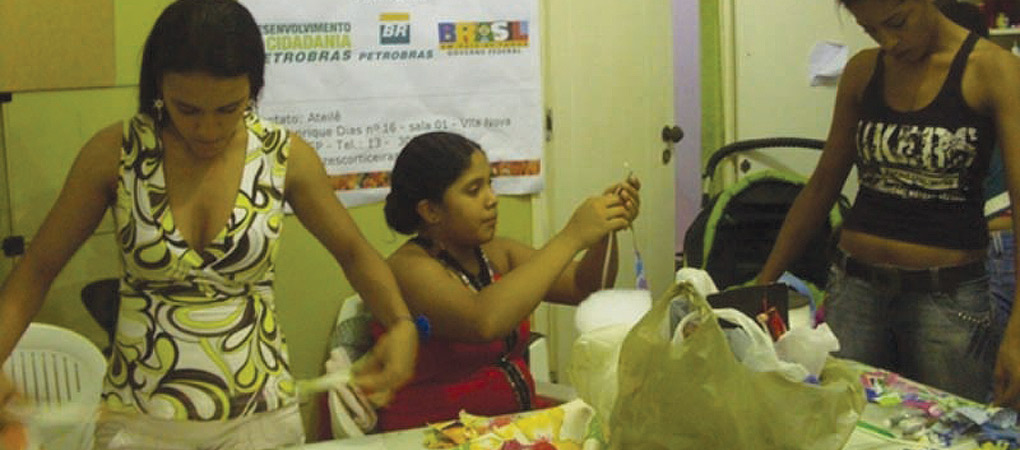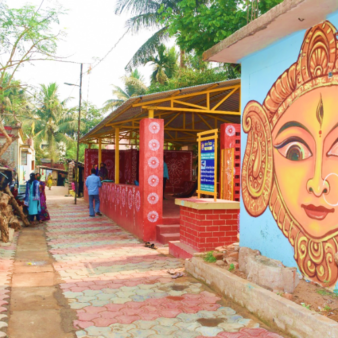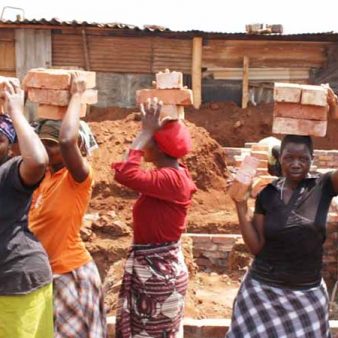The Associação Cortiços do Centro, Condomínio Vanguarda (Association of Tenements in Central Areas – ACC) is a grassroots organisation comprised of residents of cortiços, or tenement-style slums in collective buildings in central areas of the city of Santos. The ACC seeks to improve the living conditions of low-income residents of five neighbourhoods in Santos city centre, working to ensure the right of low-income families to have access to decent housing whilst remaining in central areas, close to jobs and making use of existing urban infrastructure. This community-initiated project involves the construction of 181 housing units for low-income families. The first 113 units are at the finishing stages and the final 68 units are due to be completed by the end of 2013.
Project Description
Aims and Objectives
The aim of the project is to provide decent, affordable housing for low-income families living in inadequate, overcrowded conditions in the city centre of Santos, addressing the issues of gentrification and displacement and working towards ensuring the right to adequate housing and the right to the city for all. Its approach seeks to empower residents to be agents of change within the community, working together to regenerate the neighbourhood and transform the reality in which they live.
Context
In the city of Santos, south eastern Brazil, approximately 14,500 people – the majority of whom are women and young people on very low incomes – live in precarious conditions in cortiços in the historic city centre. Houses built in the late 19th and early 20th century for well-off families have fallen into disrepair and now house up to 24 families each in overcrowded conditions, lacking in privacy, adequate sanitation, lighting or ventilation. Residents must pay very high rents and are often under threat of eviction. The area is known as having the highest rate of tuberculosis in the country, as well as the highest proportion of people living with HIV in Latin America.
Over the years, many government initiatives have been announced to improve the living conditions of residents in the area. The majority of these have not come to fruition, causing residents to become despondent and lose hope. In addition, a process of gentrification has begun to take place in the historic central areas, with rising property values due to a regeneration initiative that has recently been announced. As a result, an increasing number of families are being evicted from their homes.
Key features
Within this context, the ACC has taken a proactive approach to addressing some of the key issues, working to mobilise the community, engage with government agencies at the local, state and federal levels and obtain the necessary resources and technical support to provide concrete solutions to the critical housing needs of cortiço residents in the city centre.
In 2007, after spending time learning from the successful experiences of other grassroots organisations and examining local, state and national legislation and potential funding streams for housing with the assistance of a group of volunteer architects, the ACC was able to obtain a 6,000m2 plot of land in the Santos city centre from the Federal Assets Secretariat of the Ministry of Planning, Budget and Management and have it classified as a ‘Special Zone for Social Interest’ (ZEIS), enabling access to funding. The following year, funding was approved for the construction of the first 113 housing units and additional funding was secured in 2010 for the second phase of the project, involving the construction of an additional 68 units through a system of mutual aid and self-management of resources. Technical assistance has been provided by the Elos Brazil Institute, the Alliance of Housing Movements and local NGO Ambienta and a number of environmental features have been incorporated into the project, including rainwater harvesting and the use of solar energy. Following the key priorities established by the ACC, the project is characterised by high quality design and construction as well as a collective, participatory approach.
Participating families were selected based on housing need, family size and level of participation in collective activities and meetings. A conscious effort was made in the selection process to include residents from particularly marginalised groups, including older persons, persons without fixed income, young people and women-headed households. Fifteen per cent of the families had already been evicted from their homes as a result of the gentrification process currently taking place.
The project comprises a multi-use group of buildings that, in addition to the 181 one-, two- and three-bedroom housing units, includes a playground, communal areas (library, community bakery, training restaurant, internet room, multi-sport area, outdoor grill, etc) and commercial units on the ground floor. From the beginning, residents have been at the centre of the process, from the initial negotiations and mobilisation to collaborating with the architects through a participatory design and planning process, working in the construction through a system of mutual aid alongside skilled construction workers contracted by the ACC, and managing the project resources during the implementation phase.
Covering costs
Total project costs are US$5.66 million and funding has been obtained from two main funding streams of the CAIXA Federal Development Bank: ‘Crédito Solidario’ (phase 1) and ‘Minha Casa Minha Vida’ (phase 2), with counterpart funding received from local and state government agencies:
- US$3.5 million in CAIXA federal funding (US$1.7 million for phase 1 and US$1.8 million for phase 2).
- US$1.5 million counterpart funding from the São Paulo state housing agency (CDHU).
- US$500,000 counterpart funding from the City of Santos.
- US$150,000 in residents’ contributions in the form of labour.
- US$12,700 was provided by the UNDP for the recreational areas for children.
In addition to contributing with their labour, self-management of the resources and construction process, residents make monthly repayments which are linked to income (ten per cent of income, or a minimum of US$25 per month, over a ten year period).
Impact
- The experience has already had an important impact, both for the residents who have been actively involved throughout the process and for other grassroots groups around the country due to the enabling policies and legislation that have been created as a result of the experience. As a result of pressures mobilisation of these groups, national legislation has been approved that enables other community-based organisations and social movements to access federal land for housing construction. The ‘Concessão de Direito Real de Uso’ [Concession of full rights to the use of land / CDRU], now allows land to be handed over to the community for social housing purposes, giving it exclusive use of the land for a period of 99 years (renewable).
- Residents have been trained in building construction and self-management of resources and have been able to access employment opportunities and set up their own small businesses. Two social enterprises, including a community bakery and jewellery-making business, are already running.
- The project has succeeded in mobilising a diverse group of people who previously felt a sense of hopelessness. Community meetings went from having 15 persons in attendance to over 300 people currently participating.
- The ACC has become a national example of struggle and victory for grassroots groups facing difficult situations and many other similar groups from around the country have learnt from the experience through direct exchanges and training carried out by the ACC.
- The project is directly benefiting 800 cortiço residents (181 families) with the construction of new housing units.
Why is it innovative?
- Partnership between a community-based organisation and government agencies at local, state and national levels.
- The ACC was the first community-based organisation in the country to secure federal land through the CDRU as well as funding for housing construction through the Minha Casa Minha Vida programme, paving the way for other similar organisations.
- Fully self-managed process, with residents involved in all decision-making, planning, resource management, execution.
- Incorporation of environmentally sustainable features in a community-led mutual help housing project.
What is the environmental impact?
- This project represents a first step towards improving overall environmental conditions in the historic city centre.
- Conventional building materials have been used in the project, most of which are locally sourced. Recycled materials have also been used in construction, including recycled timber and roofing tiles made of recycled Tetrapak and toothpaste tubes.
- In addition to providing safe drinking water and energy to residents previously living in precarious housing conditions without access to adequate services, the project also incorporates a range of environmental features such as rainwater harvesting systems and the use of solar energy for lighting common areas. Exchanges carried out by the ACC with other community groups have led to other housing projects adopting a similar approach.
- An individual metering system is used to increase awareness of energy use and encourage energy efficiency.
- A mini recycling centre has been established and environmental education activities are carried out with residents to encourage sustainable living practices.
Is it financially sustainable?
- Funding for both phases of the project has been secured and includes post-occupancy work. Residents are responsible for ongoing management and maintenance.
- The ACC is in negotiations with local and federal government agencies to obtain land and funding for future projects.
- Income generation is key element of the project, with three social enterprises established to date, including a community bakery, a jewellery-making enterprise using recycled materials and a training restaurant. Spaces for these and other small businesses are included on the ground floor of the buildings, which are open to the wider community.
- ACC has obtained funding to support the above income-generating activities from a range of sources, including the state-run energy company Petrobrás, HSBC Institute, Libra Terminais, and CAIXA’s ‘Housing and Citizenship’ NGO.
- The project is affordable even for those on the lowest incomes. Household income must be less than three times the minimum monthly wage (i.e. approximately US$945 per month maximum). Repayments are linked to income, with residents paying ten per cent of their income in monthly instalments, over a period of ten years.
- The combination of contributing their labour in the construction process along with affordable repayments has enabled families who would never previously have had the means to do so to have access to decent housing.
What is the social impact?
- One of the aims of the ACC is to reduce the extreme social and economic inequalities prevalent in Brazilian society and to ensure access to land, housing and employment for low-income groups.
- The project approach and mutual help construction process promote the values of solidarity and cooperation, prioritising collective action and social integration. Social inclusion is a key priority of project and residents include traditionally excluded groups, promoting the participation of all with the same rights and responsibilities, regardless of any social, ethnic or cultural differences. Women are active in leadership roles within the ACC and 80 per cent of the property titles are in the names of women.
- All decision-making is carried out in Assemblies and residents work together at all stages of the process. The experience has brought together residents from different backgrounds and helped to create strong social networks.
- Residents have gained skills in construction, community organising, dealing with social and legal aspects, procurement and financial management through the self-managed mutual help housing process. The three social enterprises that have been created involve a strong training element, and training is also provided in areas such as non-violent communication and human values.
- Residents are empowered to take a leading role in the process, acquiring knowledge and experience. They have successfully lobbied different branches of government.
- The process of self-management and collective production confirms the sense of belonging, increases self-esteem, provides greater security and enables residents to subsequently address other problems they may be facing.
- ACC members have attended international events and exchanges, and the skills and abilities of other grassroots groups have increased as a result of these.
- The project provides decent, safe and sanitary living conditions, in contrast to living conditions in the tenements. Monthly workshops are carried out with residents and healthcare professionals, with a view to preventing some of the more prevalent diseases in the area including HIV/AIDS, tuberculosis, STDs, hepatitis and others.
Barriers
- A company that was contracted to work with the residents in the first phase of the project did not fulfil its contract, leading to a one year delay until the matter could be resolved. Despite this setback, the first phase of the project is now nearing completion.
- The counterpart funding from the municipal government was only received in late 2012. Given the fact that the project is located in an area where land speculation is high, the local government had limited interest in being a partner in the project. Through various demonstrations and negotiations, the ACC was finally able to obtain the promised funds.
Lessons Learned
- The key lesson learned is that no matter how long it takes it is important to never give up on your dreams. The struggle has taken several years, people have come and gone, but the dream was kept alive until the goal was realised.
- It is important to study all of tools that are available to help to secure funding and maximise the resources available.
- Regarding the process itself, a key lesson is that working with people requires care and understanding – it is important to recognise that diversity enriches rather than divides.
Evaluation
Regular monitoring is carried out both by the ACC (on a monthly basis), as well as by the CAIXA Federal Development Bank.
Transfer
The project has received considerable local media coverage as well as featuring in two national TV programmes. Short films and documentaries have also been produced and many visitors have come to see the project, including grassroots groups, community leaders, international visitors and university students.
The project was extended to include a second phase, with the additional 68 units that are currently under construction.
The ACC is in negotiations with the Federal Assets Secretariat for more areas to be allocated both for new construction and the renovation of historic properties for social housing purposes, to help address the demand. Advanced talks are underway for the concession of an area of 100,000m2 to the ACC.
The ACC has carried out a number of workshops and exchanges with other communities to transfer knowledge and tools, and a blog has been created to share the experience more widely.
The ACC is currently advising two other community based organisations in the city who have secured land on which to build approximately 500 housing units.
The work of the ACC has led the Mayor of Santos to announce that further projects will be carried out in central areas to provide housing for low-income families. Funding is currently being sought for a comprehensive programme to transform historic buildings in the city centre into housing for low-income families currently living in cortiços.



